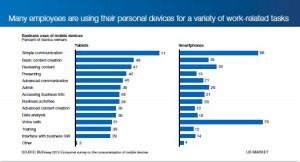
In today’s tech-savvy world, employees are being encouraged to embrace innovation and trends by integrating their own personal mobile devices into the enterprise IT fabric.
If one gauges at the enterprise IT trend of past 20 years or so, one can easily find how first laptop freed PC users from their desks, making it an essential at almost every home. Meanwhile, today, one can witness an evolved paradigm shift in IT innovation. Even outside their office premises, consumers (read: employees) are constantly discovering new consumer-empowering technologies that they are fining better than corporate tools. Hence, a trend has emerged bringing together personal and corporate productivity tools into a single platform, BYOD – a revolutionary collaboration style of mobile productivity.
Bring Your Own Device (BYOD) is a tactic to boost productivity and performance while on the go, hence meeting company’s goal by saving costs tremendously. As the terms BYOD suggests, it let employees’ access information anywhere, anytime from a personal machine owned by them.
If one looks at a 2012 survey of 3,000 workers who use mobile devices for their job, it shows that around 80 percent of smartphones used by employees are personal gadgets. These devices are used for not just business calls and emails, but also to get hold of employers’ data, applications and intranet.
Source: http://www.cisco.com/c/en/us/solutions/collaboration/UC_enable_mobile.html
Advantages of BYOD
It basically helps in developing, providing and managing enterprise mobile activity most effectively because of the following advantages:
- Based on the strict beneficial principles of work mobility, BYOD is a great way for people to feel more productive and confident, not to forget comfortable, when they are working on their self-owned machines.
- Eradicating the burden of carrying and holding multiple devices, it helps in employee satisfaction by letting them use devices they have chosen and invested in.
- By adopting BYOD policy, one also tends to skip all the downtime required for setting up or getting used to a newly acquired device.
- Personal devices often tend to be upgraded and updated versions, thus giving the enterprise direct benefits from the latest feature without spending a dime.
- They ensure seamless business integration supported by innovative forms of communication and collaboration features.
Top 8 Unheard Facts About Business Mobility and BYOD*
- It is expected that there will be around 2 billion mobile handsets in the world by 2015.
- Shipment of mobile phones on worldwide level will reach around 480 million, out of which nearly 65% will be utilised for BYOD.
- Around 66% companies will let employees bring their own mobile devices to office on daily basis. Some of them might make it as a mandatory rule, too.
- If not more, around 70% of professional will make use of their own devices by the year 2018.
- 38% of estimated organisations will not provide devices to their employees by 2016.
- The global enterprise mobility market will touch $140 billion by the year 2020, annually.
- 67% of IT employees are of an opinion that BYOD will affect their business with as much impact as the advent of internet in 1990s did.
- Biggest Mobility Challenges would be to:
Ensure mobility skills among employees: 40%, Empowering people while making technology secure: 39%, Detecting cost/ROI of mobile solutions: 35%
*The above mentioned unique facts about business mobility and BYOD are assembled based on research from top-notch organisations, such as Cisco, CompTIA, Gartner, IDC, the SANS Institute and Visage Mobile.
Source: http://www.baselinemag.com/mobility/slideshows/surprising-facts-about-mobility-and-byod.html
Who Else Is Supporting BYOD?
Zoom outside the business world, and one will find that BYOD, as a concept, is becoming extremely popular in education industry where students prefer to carry their personal data.
Mentioned below is data from Cisco BYOD Insights of 2013 for usage of BYOD spanned across different industries and cities.
Industry vs % of people using smart phone technologies for work purposes
Banking – 83.3%
Education – 95.2%
Foodservice/Hospitality – 80.4%
Healthcare – 88.6%
Legal – 78.6%
Manufacturing – 80.7%
Retail/Wholesale – 77.1%
Technology – 90.4%
City vs % of people using smartphone for work purposes
New York – 91%
Los Angeles – 90%
Chicago – 88%
Dallas – 91%
Atlanta – 89%
St. Louis – 88%
Tampa – 85%
Louisville – 88%
BYOD and Related Security Concerns
There are some prospective concerns, nevertheless, as enterprises might lose some power over how their important data is accessed, shared and stored. One of the biggest concerns is security limitation, as the data is bound to go outside company’s network. Hence, the need of the hour is for an enterprise is:
- To employ a strict BYOD IT arm that responsibly ensures that everything is rightfully secured and encrypted.
- To allow cross-platform accessibility for BYOD but with unique web-based apps that would deliver similar experience consistently on all platforms.
- To develop a formal policy that enlists all the rules and regulations before using personal technology, thus preventing unauthorised use access or transfer of case-specific data.
There you have it; the era of company-issue mobile gadgets may just be breathing its last life. Employees, across a wide genre of sectors, are now sitting in executive offices sporting their own-bought mobile devices, tailored to individual preferences. By nailing the concept of being productive at all times, employers are expected to tightly integrate the BYOD trend by merging the personal and professional tools on one platform.









